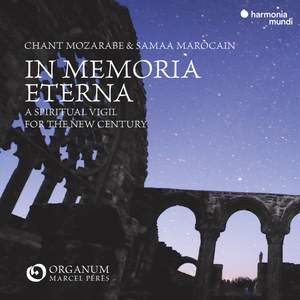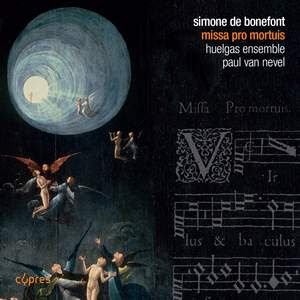Program: #21-37 Air Date: Sep 06, 2021
To listen to this show, you must first LOG IN. If you have already logged in, but you are still seeing this message, please SUBSCRIBE or UPGRADE your subscriber level today.
We presented an extensive set of memorial works after 9/11 in 2001; we remember 20 years later with Mozarabic chant, the Requiem of Simone de Bonefont, and New York Polyphony’s latest recording.
I. In Memoria Eterna: A Spiritual Vigil for the New Century (Organum/Marcel Pérès). Harmonia Mundi CD HMM 905319.

In 1997, Marcel Pérès and his Ensemble Organum began a simultaneous exploration of the Mozarabic rite (the liturgical chant peculiar to the Christians living in Spain at the time of Arabrule) and of the Samaa spiritual practice of Morocco.
Setting aside the theological differences between the two faiths, the artists discovered a great deal of kinship between the two forms of musical expression.
A veritable utopia, the idea for this recording then suggested itself: to regain the lost accord of human brotherhood through music.
-
- Recitative "Zidni bifarti" (3:41)
- "Per gloriam nominis tui Christe filius dei vivi" (Opening of the Mozarabic Mass) (3:02)
- "Allaho akbar" (Muslim Call to Prayer) (3:22)
- Alleluia "Beatus homo" / "Et erit tamquam lignum" / "Kam laka mine ni'matine alaya" (7:44)
- "In omnem terram exivit sonus" / "Non sunt sermones neque loquelle" / Prosula (7:02)
- Laetatus sum (2:06)
- Introit "Benedicam te" (4:45)
- Prosula "Ahmadou al hadi" (1:45)
- Alleluia - Verses 1, 2, 3 (5:34)
- Prosula "Tarakto baba arraja" (3:02)
- Recitative "In medio ecclesie aperuit os ejus" (2:26)
- "Os iusti meditabitur justitiam" / "Lex dei eius in corde ipsius" / "Tin dalalan" / "Ya alima l'aasrar" (7:35)
- "Levavi oculos meos in montes" (3:17)
- Alleluia "De profundis clamavi ad te Domine" / "Ya rabi bihim" (6:27)
- "In memoria eterna erit justus" - Verses 1-4 (14:26)
II. Simone de Bonfont: Missa Pro mortuis (Huelgas Ensemble/Paul van Nevel). Cypres CD CYP1682.

Paul van Nevel’s Huelgas Ensemble, singing with two voices per part, are well equipped to perform the work, with the exemplary sound, balance and vocal purity which they always show in renaissance music. This is a fine Requiem Mass, predominantly poised, consolatory in mood but with occasional striking dissonances. Completing the programme in similar vein, it’s followed by four different settings of the ‘Media vita in morte sumus’ text, from Arnold von Bruck (in German), Jacobus de Kerle, Orlandus Lassus and Nicolas Gombert. I especially appreciated the graceful, soaring lines of the Lassus work, as well as Gombert’s opening of rich, low-voiced textures.
While the main work may arguably fall a little short of its greatest renaissance counterparts from Lassus, Victoria and Morales, Bonefont’s is nevertheless a fine work and, for renaissance enthusiasts, interesting and well worth getting to know. Its performance here from Van Nevel’s ensemble is outstanding – both heartfelt and technically impeccable. So it would be most interesting to hear more by the composer but sadly, as Van Nevel tells us in his very informative booklet essay, this and three chansons are all the music known today from this very impressive musician.
This is an excellent live recording from the abbey church in Leuven, Belgium, with no audible sounds at all from the audience. Texts and translations are included.
-
- Introitus: Requiem æternam (6:11)
- Kyrie (2:10)
- Graduale: Si ambulem (5:14)
- Offertorium: Domine Jesu Christe (9:23)
- Sanctus (4:10)
- Agnus Dei (5:17)
- Communio: Lux æterna (3:20)
- Mitten wir im Leben sind, Composed By – Arnold Von Bruck (4:55)
- Media vita in morte sumus, Composed By – Jacobus de Kerle (5:46)
- Media vita in morte sumus, Composed By – Orlandus Lassus* (5:25)
- Media vita in morte sumus, Composed By – Nicolas Gombert (6:23)
III. And the sun darkened: Music for Passiontide (New York Polyphony). BIS CD BIS-2277.

The remaining tracks on And the sun darkened serve to unify the program, intertwining elegiac themes and providing attractive variances in color and texture. Josquin des Prez’s (c. 1450–1521) Tu pauperum refugium mirrors the supplications found in Compère’s Officium in a plaintive, declamatory style. The settings of the Pater noster and Ave Maria by Adrian Willaert (c. 1490–1562) illustrate the text through a kaleidoscopic interplay of voices. Joining Smith’s Salme 55 in providing modern sensibility, Taaveti laulud by Estonian composer Cyrillus Kreek(1889 –1962) injects an unexpected and gratifying intensity to the program. A passionate setting of Psalm 22 composed in 1914, Taaveti laulud deploys floor-to-ceiling chord voicings, biting harmonies, and stark dynamic contrasts. The album ends with Pierre de la Rue’s (c. 1452–1518) radiant O salutaris hostia.The motet’s calm harmonic rhythm and gradually divergent vocal lines billow to a cascading conclusion – a prayerful closure to a beautifully sung and thoughtfully programmed recording.
-
- Loyset Compère (1445-1518): Crux triumphans
- Josquin des Prez (1450-1521): Tu Pauperum Refugium
- Andrew Smith (b. 1970): Salme 55 (Psalm 55)
- Adrian Willaert (1490-1562):
- Pater noster
- Ave Maria - Cyrillus Kreek (1889-1962): Taaveti laulud (Psalms of David): Psalm 22, "Mu Jumal! Mu Jumal!" (My God, my God?)
- Loyset Compère: Officium de cruce, "In nomine Jesu”
- Pierre de la Rue (1452-1518): O salutaris hostia
Composer Info
Simone de Bonefont, Loyset Cmèe (1445-1518), Josquin des Prez (1450-1521), Andrew Smith (b. 1970), Adrian Willaert (1490-1562), Cyrillus Kreek (1889-1962), Pierre de la Rue (1452-1518)
CD Info
Harmonia Mundi CD HMM 905319, Cypres CD CYP1682, BIS CD BIS-2277